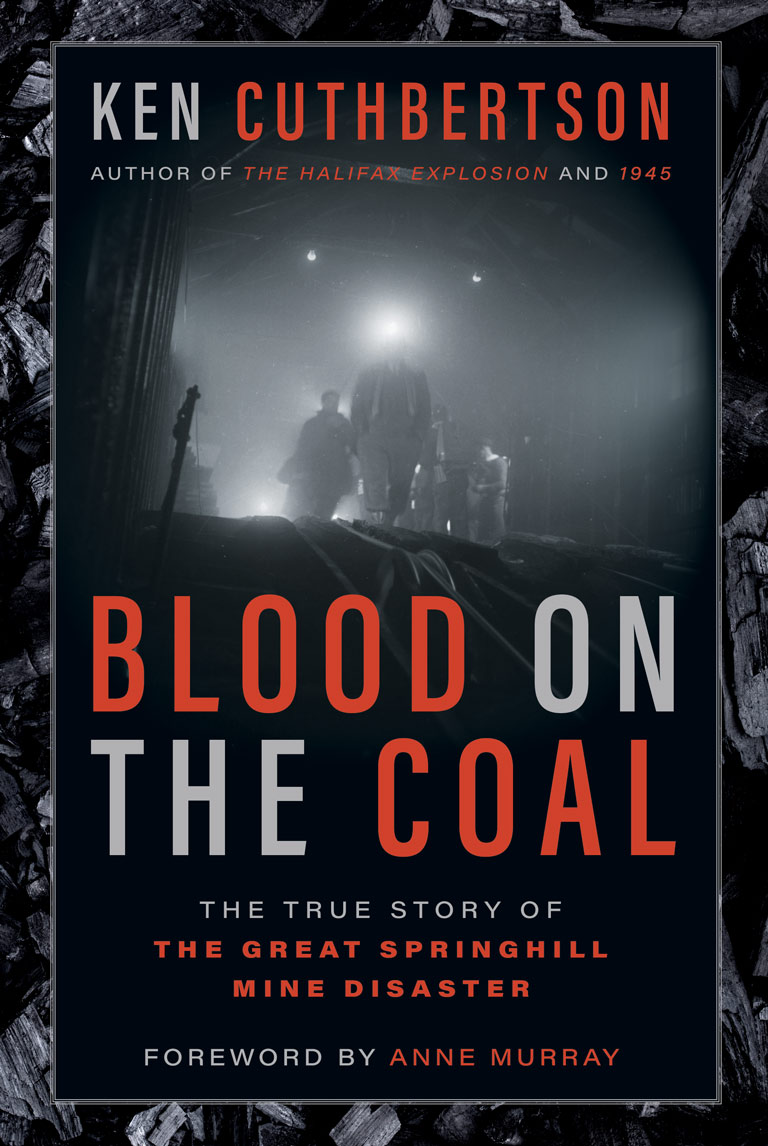Blood on the Coal

Blood on the Coal: The True Story of the Great Springhill Mine Disaster
by Ken Cuthbertson
HarperCollins
366 pages, $36.99
In mining parlance, a “bump” is an underground upheaval. As Ken Cuthbertson writes, a “Big Bump” is what produced the 1958 Nova Scotia mining disaster that stunned a company town and shocked the world. In his retelling of the tragic event, readers are intimately immersed in the nine-day-long crisis leading to the rescue of only some of the men who had been underground.
Bumps were familiar to Springhill, Nova Scotia, coal-mining families. In 1956 they experienced a smaller bump that nonetheless took the lives of thirty-nine men. Then the October 23, 1958, bump killed seventy-five miners in a tragedy whose story raced around the world through media reports that were sometimes disturbingly heartless.
Cuthbertson’s book Blood on the Coal tells about the miners who survived thanks to “the miracle at Springhill.” It’s a book about the courage and heartache experienced as families awaited news regarding the fate of the nineteen survivors from deep in the No. 2 mine where the incident occurred. It’s also about the bravery of the “draegermen and barefaced miners” who eventually rescued them.
“The Bump ripped the soul out of the town,” Cuthbertson writes. His book documents the geology, geography, and history behind the event, and his hour-by-hour script of that horrible week is time-stamped as he takes readers both underground to the injured survivors and topside, where we learn of people’s pained responses to the event.
Cuthbertson brings us to the coal face to meet the miners themselves, both those who survived and those who didn’t make it. We learn about their daily lives, inner thoughts, hopes, families, and social habits, even their biases and fears. He creates a breathless reading experience, through which we can almost feel the choking coal dust and deadly firedamp (gas) in the confined space of the mine.
We meet Maurice Ruddick, “the singing miner” and the hero of the trapped men. A father of twelve children, Ruddick was also subjected to prejudices faced by Afro-Canadians. “He kept them laughing and he kept them singing,” said one observer. A favourite tune was “Away Down in the Deeps,” which conveyed the men’s sense of resolve: “If we should die in the deeps, boys,/ We know where we’ll go,/ Heaven, boys, is away way above,/ and hell is right here below.”
With 7 uniquely curated newsletters to choose from, we have something for everyone.
Another hero is Dr. Arnold Burden. He accompanied rescuers into the doomed coal pit to help the “Twelve” and the “Seven,” as the two separate groups of rescued men were christened. Burden was a colleague to Dr. Carson Murray, father of the famous singer Anne Murray (the latter wrote the foreword to the book). Burden later joined two of the miners as guests on The Ed Sullivan Show. Sullivan contributed $1,000 to the Springhill Disaster Relief Fund, which raised $2 million from thousands of other donors in support of the surviving families.
We also meet Harold Brine, a young man who cherished his 1950 Ford Meteor. Brine got the thrill of a lifetime when Prince Philip visited his hospital bedside after the accident. He was building a new home before the bump but abandoned it when the Dominion Steel and Coal Corporation closed the mine for good after the 1958 bump. Brine died in the summer of 2023 at ninety-one years old, the last survivor of the disaster.
As part of a publicity stunt meant to aggrandize the governor of Georgia, Marvin Griffin, thirteen of the survivors and their families enjoyed an all-expenses-paid holiday to Jekyll Island State Park. But things did not go well for the segregationist governor. When he forced Ruddick and his family to stay apart from the others, media reports exposed the racism.
As the years passed, the memory of the “miracle” continued to generate interest. Books were written, studies were conducted, songs were sung, and a public inquiry was held. The popular TV show Front Page Challenge hosted Ruddick as a guest. Springhill itself was left to struggle for its survival. Today the town is filled with commemorative plaques, cemetery headstones, and museum displays that mark the disaster.
Sadly, “Ol’ King Coal” survives as well, Cuthbertson laments, after noting the world’s increasing concerns about global warming. Coal plays a big part in it, and he points out that “Canada ranks thirteenth globally in coal production.” Mining companies continue to seek their fortunes in the coal pit, and miners still go into the depths to collect a substance that is ultimately contributing to catastrophic climate change.
We hope you’ll help us continue to share fascinating stories about Canada’s past by making a donation to Canada’s History Society today.
We highlight our nation’s diverse past by telling stories that illuminate the people, places, and events that unite us as Canadians, and by making those stories accessible to everyone through our free online content.
We are a registered charity that depends on contributions from readers like you to share inspiring and informative stories with students and citizens of all ages — award-winning stories written by Canada’s top historians, authors, journalists, and history enthusiasts.
Any amount helps, or better yet, start a monthly donation today. Your support makes all the difference. Thank you!
Themes associated with this article
Advertisement
Save as much as 40% off the cover price! 4 issues per year as low as $29.95. Available in print and digital. Tariff-exempt!




